Pros
Cons
Introduction
When it comes to performance the {{product.name}} is not spectacular, and we were a bit dismayed by its inconsistency. But the strong design, high efficiency, and large number of cycle options raise the {{product.model}} into the realm of justifiable expenses.
Front
{{section_header}}{{section.name}}{{/section_header}}
The front of the {{product.model}} is plain and simple. The stainless steel is pretty sensitive to fingerprints, but the sturdy, angular handle gives the whole thing a sort of domineering look. We did notice, however, that the door opening resistance seemed a bit heavy.
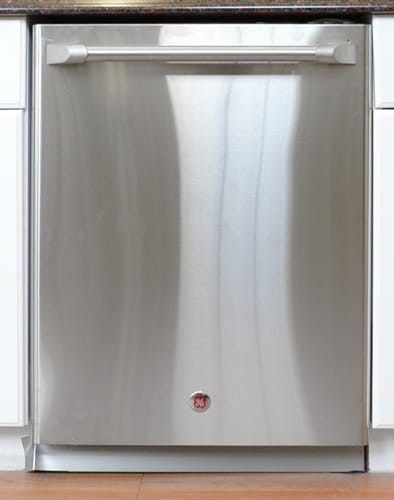
The front of the GE CDWT980VSS.
Finish
{{section_header}}{{section.name}}{{/section_header}}
The exterior is matched by a stainless steel wash tub, which was surprising in how ineffective it was at suppressing noise.

Controls
{{section_header}}{{section.name}}{{/section_header}}
The lack of buttons and basic interface design makes the {{product.model}} seem simple and easy to use. For the most part it is, but the cycle selection seems a bit more complicated than it needs to be. Putting functionality aside, the control panel is simply designed and intuitive enough.
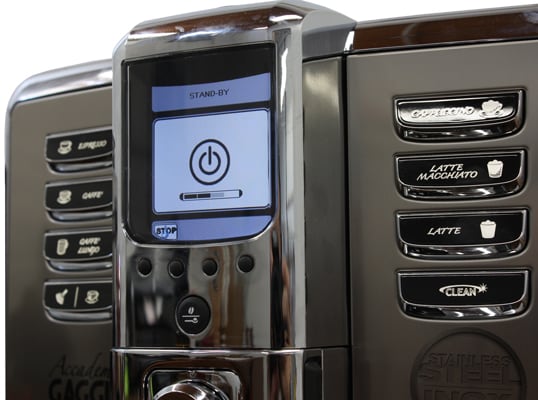
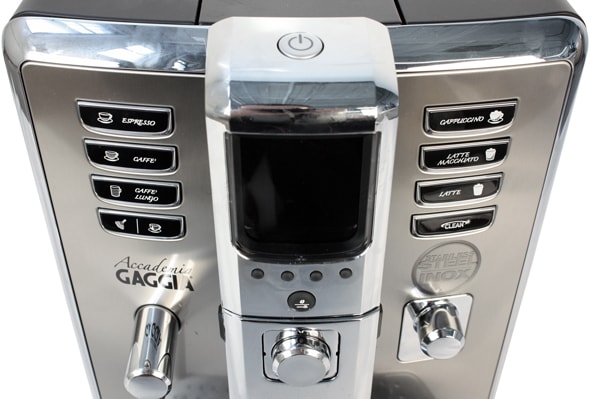
Interior
{{section_header}}{{section.name}}{{/section_header}}
The stainless steel interior looks nice, as do the two dish racks, despite their somewhat clunky usability.
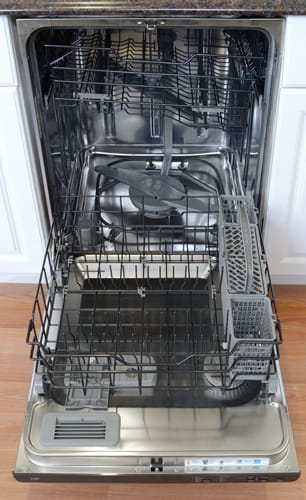
The CDWT980VSS with door open.
Top Rack
{{section_header}}{{section.name}}{{/section_header}}
The top rack cannot be adjusted and the tines seemed a bit too close together. But for the most part, this doesn’t get in the way of the machine’s loading capacity.
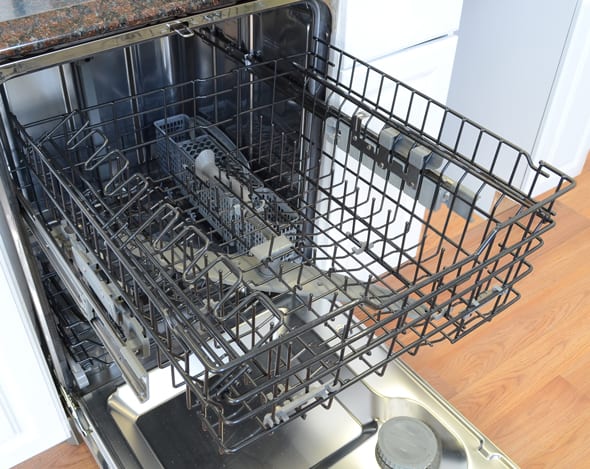
The top rack of the CDWT980VSS.
Bottom Rack
{{section_header}}{{section.name}}{{/section_header}}
The bottom rack has some unique—or perhaps, unusual—design elements. The tines, which are a tad flimsy, are angled in a precise way, and seem to dictate which sorts of dishes should be placed where.
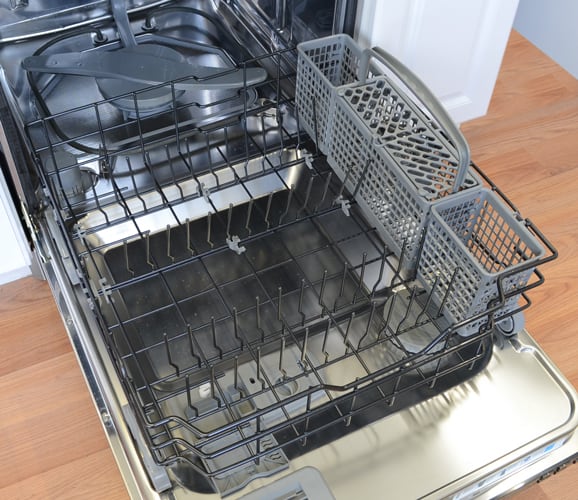
The bottom rack of the CDWT980VSS.
Cutlery Basket
{{section_header}}{{section.name}}{{/section_header}}
To our great frustration, we found it impossible to lock both of the cutlery baskets in their designated space at the front of the bottom rack. This was absurd. There are latches for exactly where the baskets are supposed to be placed, but the placement of the tines on either side of the basket space made it impossible to fit. Infuriating. Why? Thankfully, the baskets stayed in place during the wash, but it was still a frustrating mystery about the machine’s design.
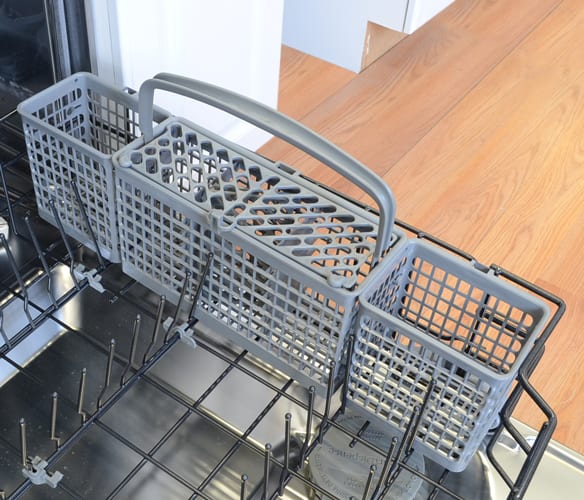
The CDWT980VSS cutlery basket.
Electricity Use
{{section_header}}{{section.name}}{{/section_header}}
While the Short cycle used a mere 0.32 kWh, the Normal and Extreme Washes were considerably more demanding, as they consumed 0.80 and 1.11 kWh, respectively. This makes for a wide ranging electricity cost of 3 to 11 cents per cycle.
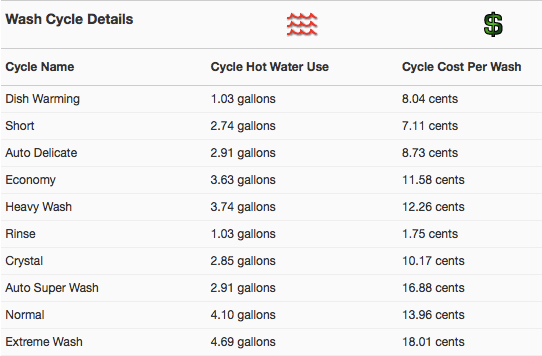
Water Use
{{section_header}}{{section.name}}{{/section_header}}
The {{product.model}}’s water consumption was much narrower. The short wash used up 2.74 gallons of hot water—a small figure that is likely the reason for its under-performance. The Normal and Extreme Washes drained 4.10 and 4.69 gallons, respectively. Each of these figures is well below industry norms, and makes for a water cost of 3 to 5 cents per cycle.
Yearly Running Cost
{{section_header}}{{section.name}}{{/section_header}}
Assuming that the Normal cycle will be used roughly 50 percent of the time, and the Short and Extreme Washes the rest of the time, we calculated that the {{product.model}} will cost about $27.59 a year to operate. That is well below average, placing the {{product.model}} among the most efficient dishwashers we’ve tested.

Washing Speed
{{section_header}}{{section.name}}{{/section_header}}
None of the cycles took more than two hours to complete. The Short wash, not surprisingly, was pretty quick, clocking in at 38 minutes. It also shouldn’t surprise you that it performed rather dismally. The Normal and Extreme Washes took 110 and 109 minutes, respectively.
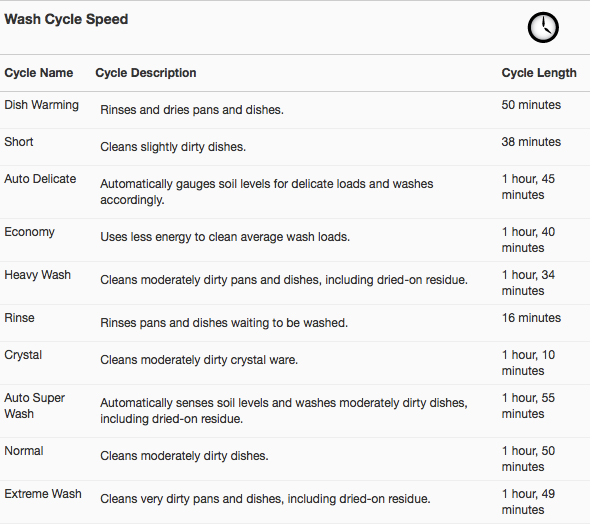
Washing Performance
{{section_header}}{{section.name}}{{/section_header}}
There was quite a range of washing power across the three main cycles we tested, not merely from wash to wash but among individual passes as well. This is usually a bad sign, as it suggests you’ll need to clean out the filter often.
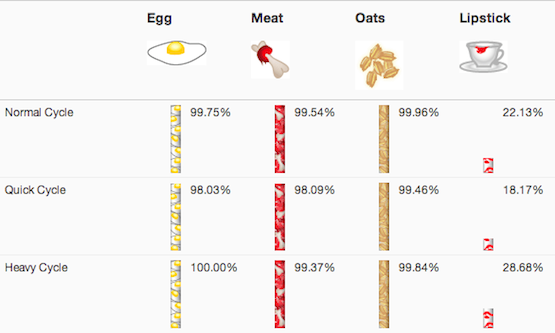
Quick Wash Cycle
{{section_header}}{{section.name}}{{/section_header}}
The Quick Cycle sure was efficient, but it was downright bad at cleaning dishes. It was particularly bad at protein-based stains. Our dried milk tests, for example, were resilient. The meat and spinach stains also left a good amount of their original matter.
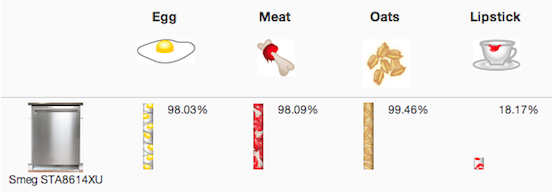
Normal Wash Cycle
{{section_header}}{{section.name}}{{/section_header}}
The Normal cycle proved much better. While it still seemed to scatter tiny food specks through the wash (mainly spinach particles), the dishes were mostly clean. The problem with this, of course, is that people don’t want “mostly” clean dishes; they want perfectly clean dishes, especially if they’re planning to drop $1,000. There was also some inconsistency across multiple runs, mainly in the baked spinach test, which was barely cleaned on the first pass and almost perfect on the second.
Normal Cycle

Heavy/Pots & Pans Wash Cycle
{{section_header}}{{section.name}}{{/section_header}}
The Extreme Wash was more consistent and did surprisingly well on our burnt cheese test, which usually proves very difficult. It also did much better on protein-based stains, likely due to the high heat of the water during this cycle (it reached a peak of 155.6 degrees, which is enough to sanitize the wash). Because the Extreme Wash is only slightly less efficient than the Normal, you shouldn’t have to worry about it costing you more to operate.
Pots & Pans Cycle
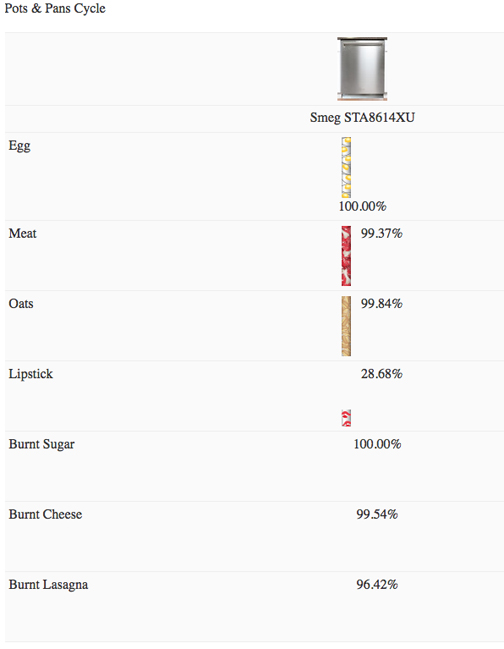
Washing Cycles
{{section_header}}{{section.name}}{{/section_header}}
There are a whopping 10 cycles in all. This may sound like overkill, but it’s due to the fact that the options usually found in other dishwashers are included in the {{product.model}} as standalone wash cycles. They include the following: Dish Warming, Crystal, Auto Super Wash, Normal, Extreme Wash, Rinse, Short, Auto Delicate, Economy, and Heavy wash.
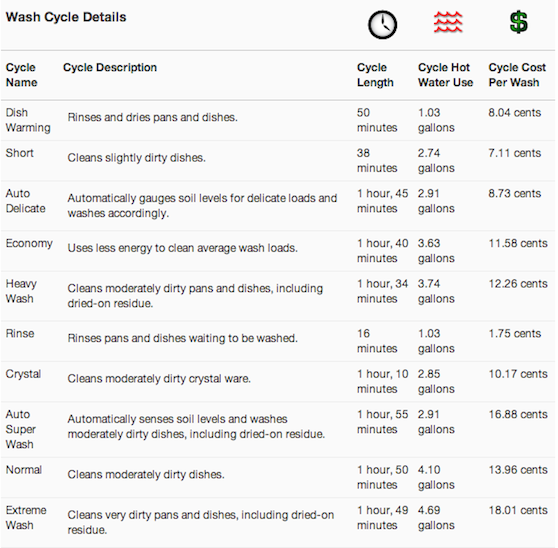
Customization
{{section_header}}{{section.name}}{{/section_header}}
The only customization option is a rack prioritization feature, through which users can choose if they only want to clean a single rack. This option is controlled by a button on the right side of the interface.

Additional Wash Options
{{section_header}}{{section.name}}{{/section_header}}
As mentioned, the standard dishwasher options—sanitize, rinse, eco wash, etc.—are all found in the {{product.model}}. They’re just within individual wash cycles. As for add-on features, the only additional option is a delay start, which can postpone the start of a cycle by up to nine hours.

Capacity
{{section_header}}{{section.name}}{{/section_header}}
We were able to fit 10 place settings, including a serving setting. This is about as standard as it gets for dishwashers.
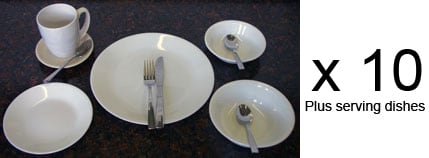
Top Rack
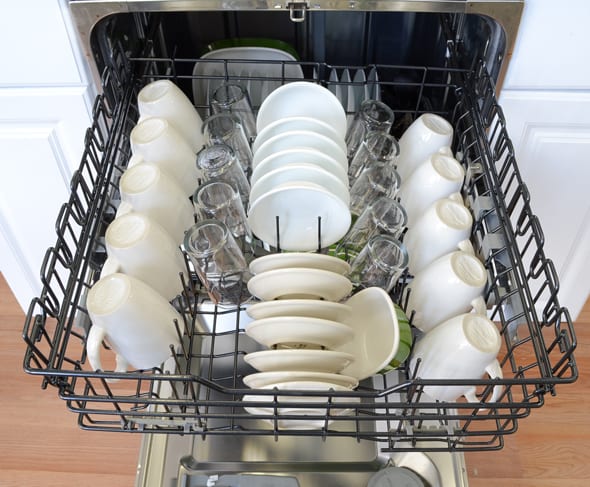
Bottom Rack
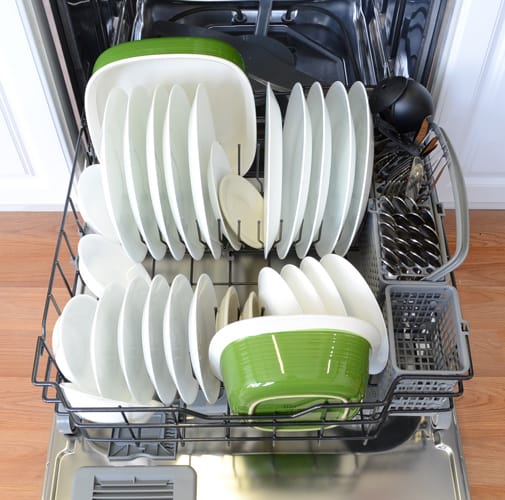
Wash Arms & Filters
{{section_header}}{{section.name}}{{/section_header}}
The top rack wash arm is plastic and dual-ended—nothing to write home about. The bottom wash arm, however, is much more interesting. It’s metallic and dual-ended, but it also includes an additional, smaller wash arm that spins on its own axis. When we first saw this we immediately hoped it would translate to superior wash performance, and maybe it did somewhat, but it was nothing amazing.
The filtration system includes a fine grain filter “plate,” plus a removable coarse grain cylinder and a finer grain filter that surrounds it.
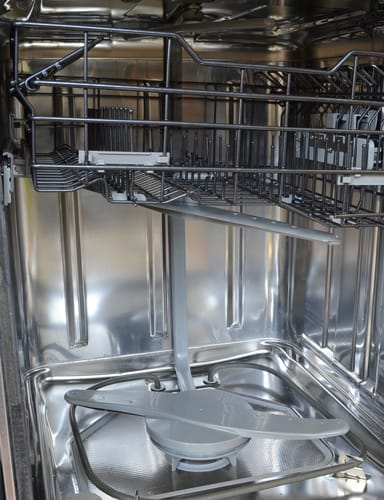
The CDWT980VSS wash arms.
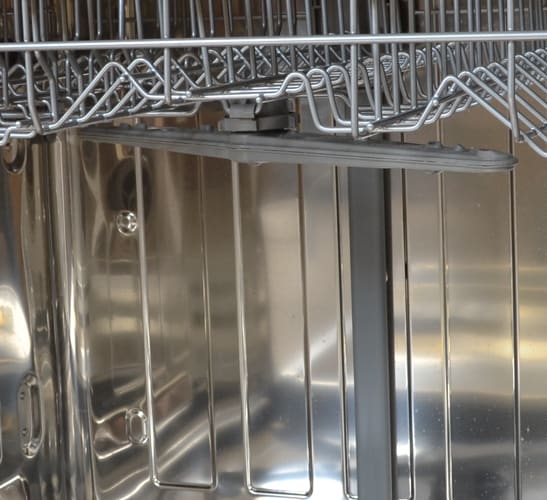
The DW 14140 upper wash arm
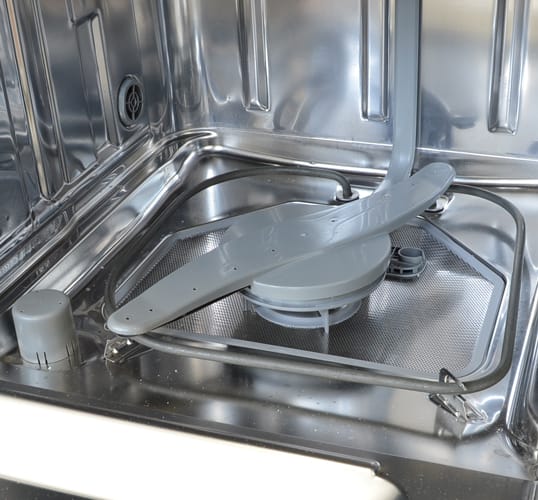
The CDWT980VSS filter.
Lower Dish Rack
{{section_header}}{{section.name}}{{/section_header}}
The lower rack features two rows of collapsible tines, both of which felt a bit flimsy. While we didn’t really have much trouble fitting the ten place settings, we felt as if the lower rack doesn’t make the best use of its space. You have to lower the tines to fit large or bulky dishes like pots and pans. This isn’t really a problem, but we found it difficult to keep these large dishes stable. We also noticed that the bottom rack seemed to “derail” a bit too easily.

The bottom rack of the CDWT980VSS.
Upper Dish Rack
{{section_header}}{{section.name}}{{/section_header}}
While the upper rack is kind of small, we were able to fit a good amount of dishware. It is sturdily built, but the angle of the spindles made it difficult to keep glasses in place.

The top rack of the CDWT980VSS.
Cutlery Holder
{{section_header}}{{section.name}}{{/section_header}}
On its own the cutlery holder, which includes two separate baskets, is nothing surprising; it does its job. But we found it impossible to securely fasten both baskets into the bottom rack—there just wasn’t enough space! Even though the baskets themselves stayed in place during the wash cycle, the fact that they couldn’t be secured was frustrating, to say the least.

The CDWT980VSS cutlery basket.
Detergent Dispenser
{{section_header}}{{section.name}}{{/section_header}}
Nothing special here. The detergent dispenser includes a deeper bay within it, plus a pre-wash dispenser on the side. There is also a rinse aid dispenser with meter and removable cap.
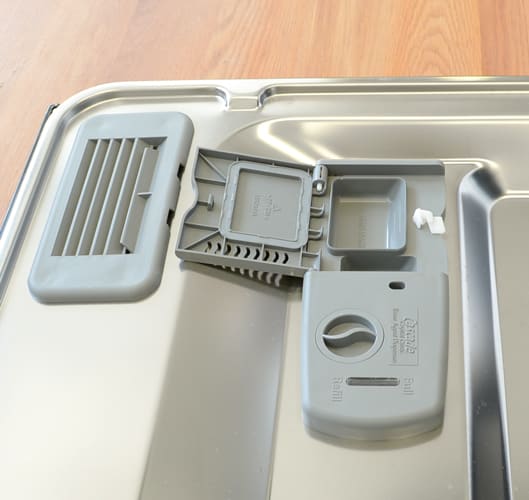
The CDWT980VSS detergent dispenser.
Ease of Use
{{section_header}}{{section.name}}{{/section_header}}
Unless you’re really troubled in the head, you shouldn’t find any difficult operating this machine. As mentioned, there are a few frustrating components that seem counter-intuitive or even silly, but we wouldn’t call any of them a deal-breaker by any means. The price-for-performance may be a legitimate issue, but not the ease of use.
Noise
{{section_header}}{{section.name}}{{/section_header}}
The {{product.model}} is surprisingly loud. Most machines with a stainless steel interior are good at suppressing noise, but not this one. And we can’t blame it on a high volume of water within the wash tub, because it doesn’t use that much water. We also noticed some strange fanning sounds during the dry cycle. Compared to, say, an industrial clothes washer, the {{product.model}} is not very loud, but compared to other dishwashers it’s pretty darn noisy.
Controls
{{section_header}}{{section.name}}{{/section_header}}
As mentioned earlier, we really liked the layout and design of the control panel. It’s very simple, but its simplicity belies a somewhat more complicated operation. The cycles are selected via a scroll button on the left side of the interface. Green indicator lights highlight which of five cycle symbols you wish to engage. Because there is no text, you have to consult a diagram on the inside of the door to figure out what means what. Also, there are only five symbols, meaning you have to hit the Supplementary Program button to engage one of the five other cycles, which then means further consulting of the diagram. It wasn’t exactly a brain-buster to figure this all out, but it did seem more complicated than it needed to be.


Efficiency
{{section_header}}{{section.name}}{{/section_header}}
One of the most efficient dishwashers we’ve tested, the {{product.model}} will run you about $27.59 a year to operate. Most of this cost-saving power stems from its low water use, which is also one of the reasons behind the mediocre wash performance.
Washing Performance
{{section_header}}{{section.name}}{{/section_header}}
Meh. We weren’t blown away, but we weren’t disappointed either. The {{product.model}} has a pretty awful quick cycle (called “Short”) that is mostly useless aside from the fact that it doesn’t use much water or energy. The Normal and Extreme Washes, on the other hand, are much better, but are not without their shortcomings. Because these latter two washes are almost the same in terms of speed and efficiency, we’d recommend using the Extreme Wash fairly often.
Features
{{section_header}}{{section.name}}{{/section_header}}
All of the {{product.model}}’s features are embedded within the individual wash cycles. Sanitize, rinse, eco wash, delicates—they’re all here, but you have to choose specific cycles to engage them, meaning customization is essentially non-existent, other than the individual rack wash option. There is also a delay feature, for folks who like to run their dishwashers when they’re not around.
Meet the tester
Tyler Wells Lynch is a freelance writer and journalist whose work has appeared in Vice, Wirecutter, Gizmodo, The Rumpus, Yes!, and the Huffington Post, among others. He lives in Maine.
Checking our work.
Our team is here to help you buy the best stuff and love what you own. Our writers, editors, and experts obsess over the products we cover to make sure you're confident and satisfied. Have a different opinion about something we recommend? Email us and we'll compare notes.
Shoot us an email

